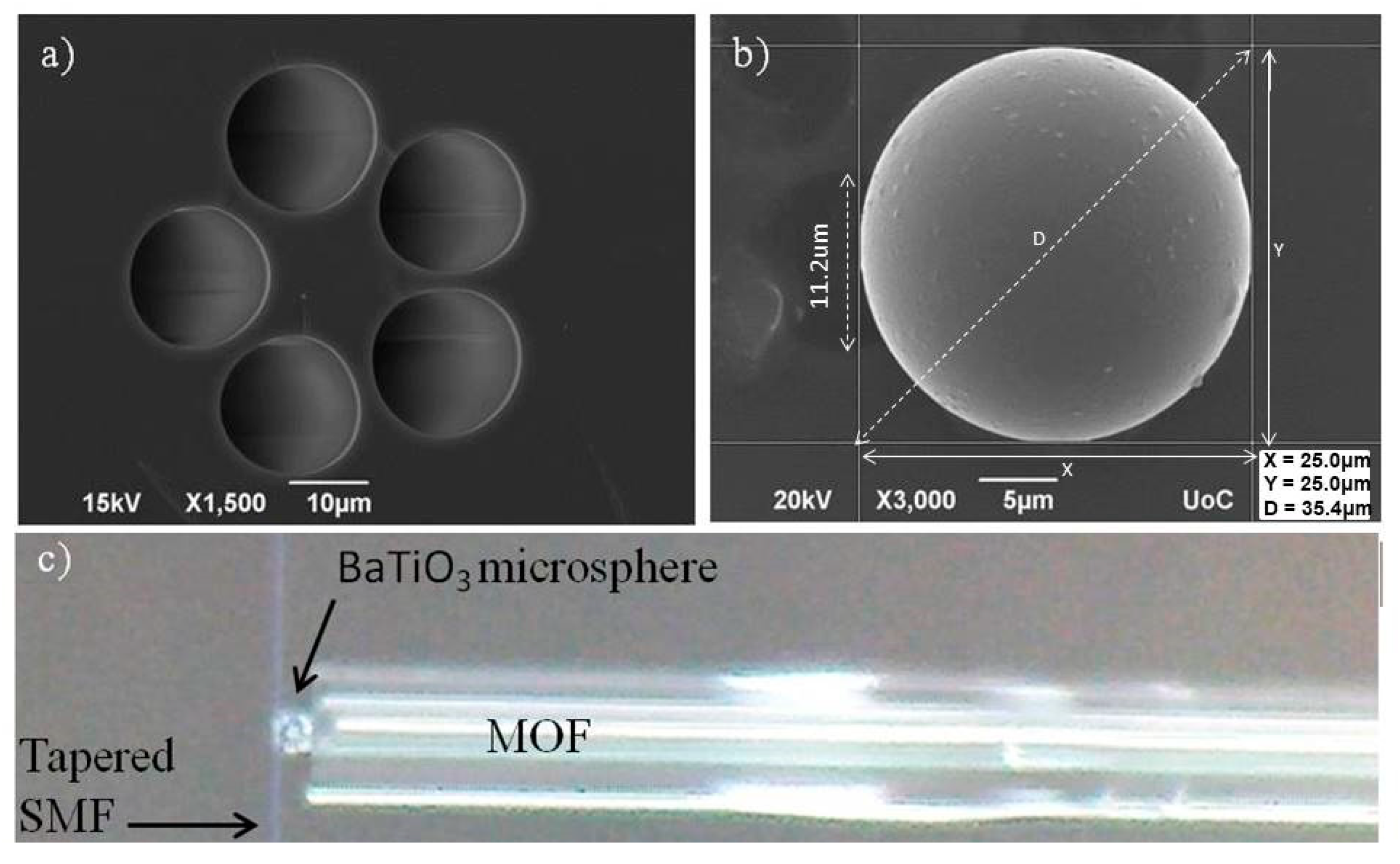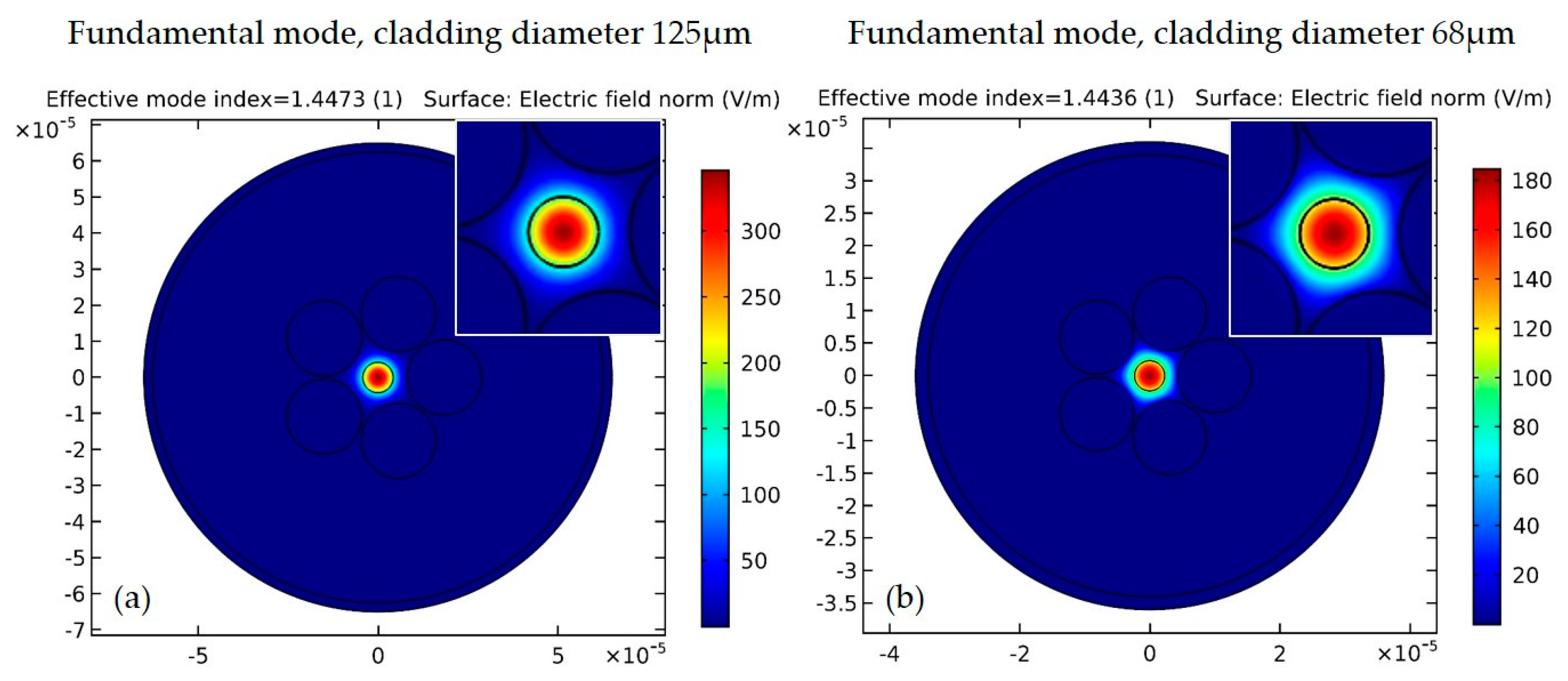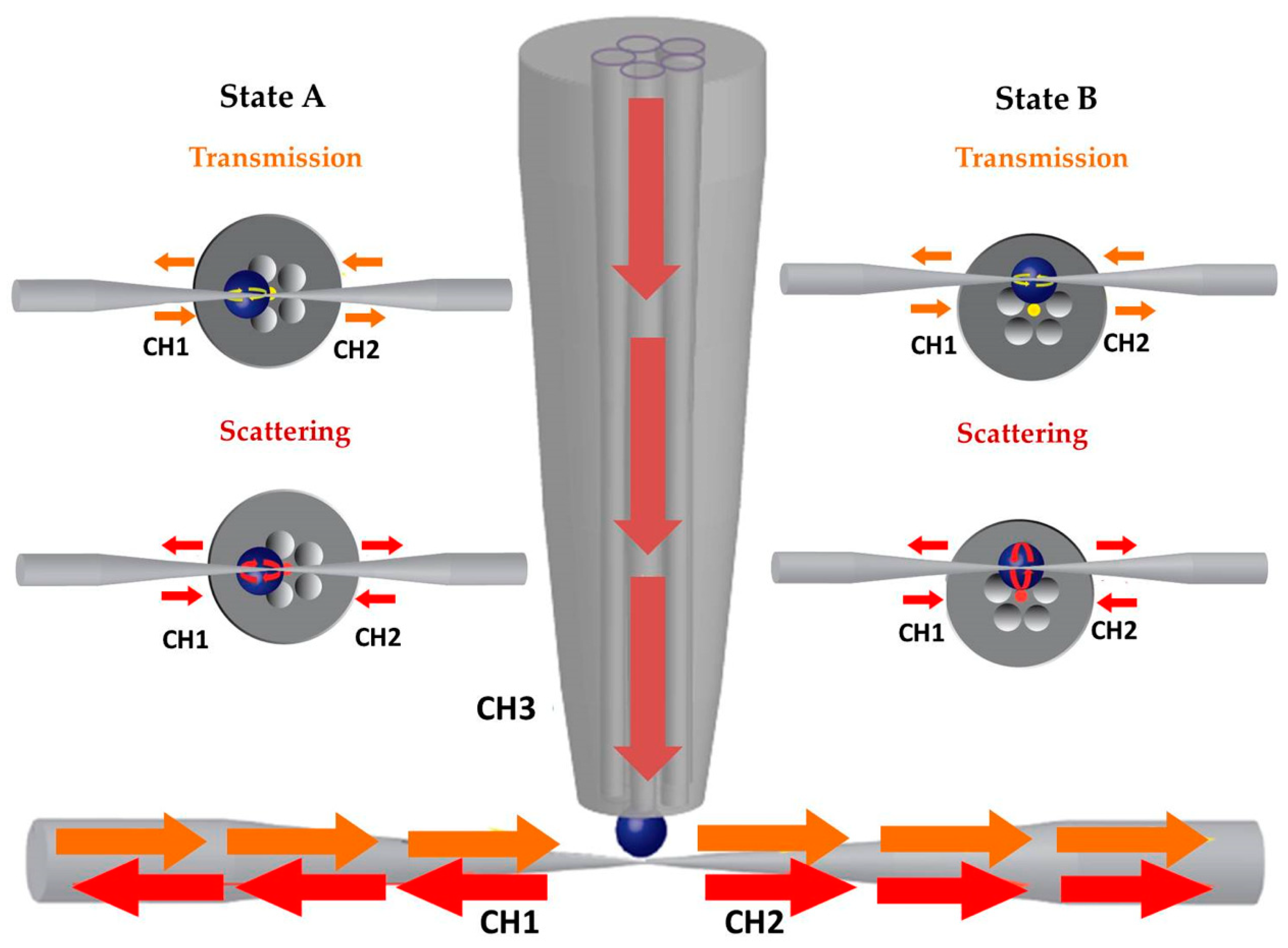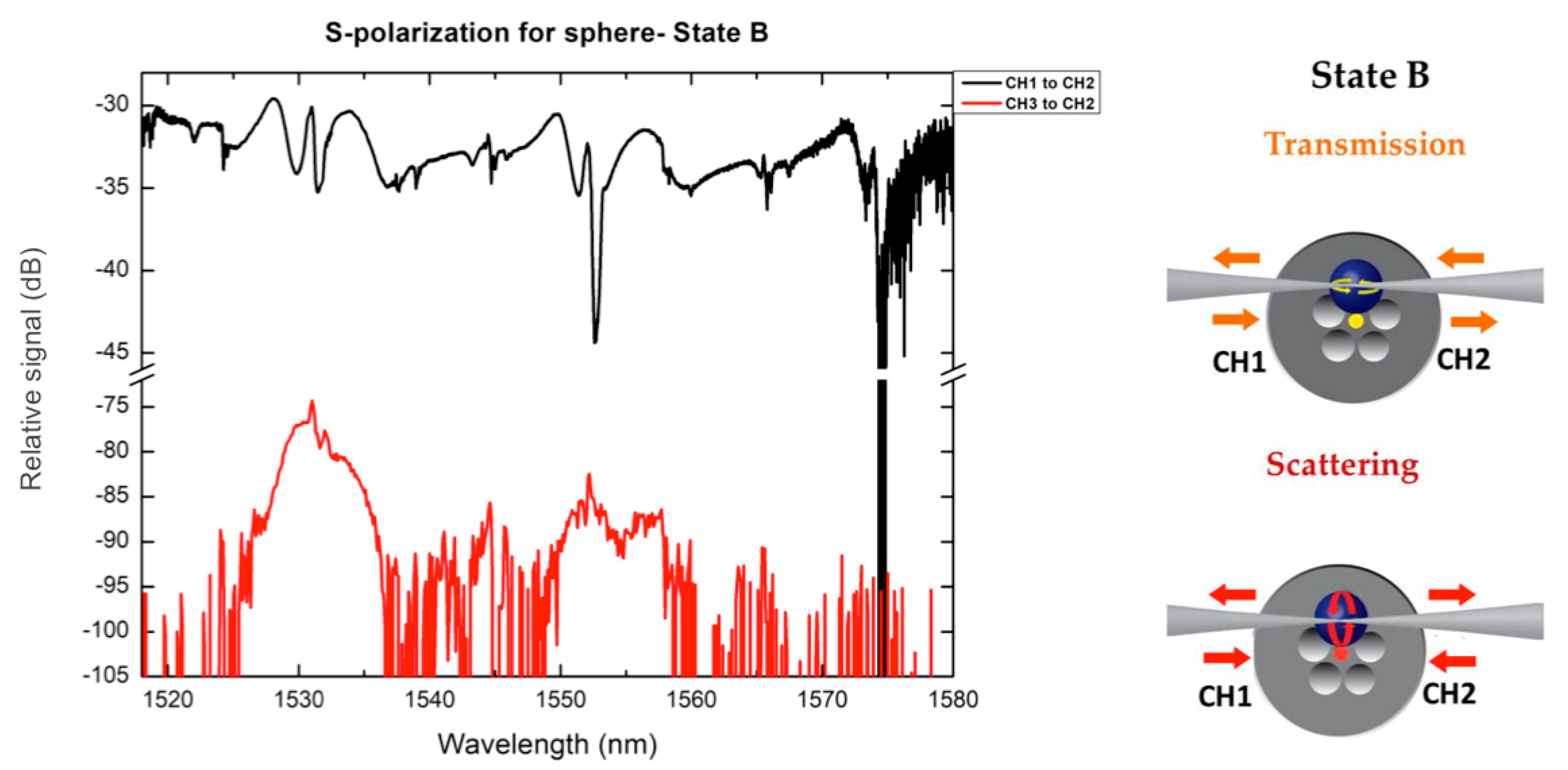Multiple Light Coupling and Routing via a Microspherical Resonator Integrated in a T-Shaped Optical Fiber Configuration System
Abstract
:1. Introduction
2. Experimental Section
3. Results and Discussion
4. Conclusions
Funding
Acknowledgments
Conflicts of Interest
References
- Chiasera, A.; Dumeige, Y.; Féron, P.; Ferrari, M.; Jestin, Y.; Nunzi Conti, G.; Pelli, S.; Soria, S.; Righini, G.C. Spherical whispering-gallery-mode microresonators. Laser Photonics Rev. 2010, 4, 457–482. [Google Scholar] [CrossRef]
- Foreman, M.R.; Swaim, J.D.; Vollmer, F. Whispering gallery mode sensors. Adv. Opt. Photonics 2015, 7, 168–240. [Google Scholar] [CrossRef] [PubMed]
- Matsko, A.B.; Ilchenko, V.S. Optical resonators with whispering-gallery modes—Part I: Basics. IEEE J. Sel. Top. Quantum Electron. 2006, 12, 3–14. [Google Scholar] [CrossRef]
- Ilchenko, V.S.; Bennett, A.M.; Santini, P.; Savchenkov, A.A.; Matsko, A.B.; Maleki, L. Whispering gallery mode diamond resonator. Opt. Lett. 2013, 38, 4320–4323. [Google Scholar] [CrossRef] [PubMed]
- Vollmer, F.; Arnold, S.; Keng, D. Single virus detection from the reactive shift of a whispering-gallery mode. Proc. Natl. Acad. Sci. USA 2008, 105, 20701–20704. [Google Scholar] [CrossRef] [PubMed] [Green Version]
- Cai, M.; Painter, O.; Vahala, K.J.; Sercel, P.C. Fiber-coupled microsphere laser. Opt. Lett. 2000, 25, 1430–1432. [Google Scholar] [CrossRef] [PubMed] [Green Version]
- Kosma, K.; Schuster, K.; Kobelke, J.; Pissadakis, S. An “in-fiber” whispering-gallery-mode bi-sphere resonator, sensitive to nanometric displacements. Appl. Phys. B 2018, 124, 1. [Google Scholar] [CrossRef]
- Riesen, N.; Reynolds, T.; François, A.; Henderson, M.R.; Monro, T.M. Q-factor limits for far-field detection of whispering gallery modes in active microspheres. Opt. Express 2015, 23, 28896–28904. [Google Scholar] [CrossRef] [PubMed] [Green Version]
- Von Klitzing, W.; Long, R.; Ilchenko, V.S.; Hare, J.; Lefèvre-Seguin, V. Frequency tuning of the whispering-gallery modes of silica microspheres for cavity quantum electrodynamics and spectroscopy. Opt. Lett. 2001, 26, 166–168. [Google Scholar] [CrossRef] [PubMed]
- Farnesi, D.; Chiavaioli, F.; Righini, G.C.; Soria, S.; Trono, C.; Jorge, P.; Nunzi Conti, G. Long period grating-based fiber coupler to whispering gallery mode resonators. Opt. Lett. 2014, 39, 6525–6528. [Google Scholar] [CrossRef] [PubMed]
- Hanumegowda, N.M.; Stica, C.J.; Patel, B.C.; White, I.; Fan, X. Refractometric sensors based on microsphere resonators. Appl. Phys. Lett. 2005, 87, 201107. [Google Scholar] [CrossRef]
- Knight, J.C.; Cheung, G.; Jacques, F.; Birks, T.A. Phase-matched excitation of whispering-gallery-mode resonances by a fiber taper. Opt. Lett. 1997, 22, 1129–1131. [Google Scholar] [CrossRef] [PubMed]
- Milenko, K.; Konidakis, I.; Pissadakis, S. Silver iodide phosphate glass microsphere resonator integrated on an optical fiber taper. Opt. Lett. 2016, 41, 2185–2188. [Google Scholar] [CrossRef] [PubMed]
- Francois, A.; Rowland, K.J.; Monro, T.M. Highly efficient excitation and detection of whispering gallery modes in a dye-doped microsphere using a microstructured optical fiber. Appl. Phys. Lett. 2011, 99, 141111–141113. [Google Scholar] [CrossRef]
- Zeltner, R.; Pennetta, R.; Xie, S.; Russell, P.S.J. Flying particle microlaser and temperature sensor in hollow-core photonic crystal fiber. Opt. Lett. 2018, 43, 1479–1482. [Google Scholar] [CrossRef] [PubMed] [Green Version]
- Maslov, A.V. Resonant optical propulsion of a particle inside a hollow-core photonic crystal fiber. Opt. Lett. 2016, 41, 3062–3065. [Google Scholar] [CrossRef] [PubMed]
- Kosma, K.; Zito, G.; Schuster, K.; Pissadakis, S. Whispering gallery mode microsphere resonator integrated inside a microstructured optical fiber. Opt. Lett. 2013, 38, 1301–1303. [Google Scholar] [CrossRef] [PubMed]
- Wang, J.; Yin, Y.; Hao, Q.; Zhang, Y.; Ma, L.; Schmidt, O.G. Strong coupling in a photonic molecule formed by trapping a microsphere in a microtube cavity. Adv. Opt. Mater. 2017, 6, 1700842. [Google Scholar] [CrossRef]
- Zhang, M.; Yang, W.; Tian, K.; Yu, J.; Li, A.; Wang, S.; Lewis, E.; Farrell, G.; Yuan, L.; Wang, P. In-fiber whispering-gallery mode microsphere resonator-based integrated device. Opt. Lett. 2018, 43, 3961–3964. [Google Scholar] [CrossRef] [PubMed]
- Kosma, K.; Konidakis, I.; Pissadakis, S. Photorefractive tuning of whispering gallery modes of a spherical resonator integrated inside a microstructured optical fibre. Eur. Phys. J. Spec. Top. 2014, 223, 2035–2040. [Google Scholar] [CrossRef]
- Savchenkov, A.A.; Matsko, A.B.; Strekalov, D.; Ilchenko, V.S.; Maleki, L. Enhancement of photorefraction in whispering gallery mode resonators. Phys. Rev. B 2006, 74, 245119. [Google Scholar] [CrossRef]
- Canciamilla, A.; Grillanda, S.; Morichetti, F.; Ferrari, C.; Hu, J.; Musgraves, J.D.; Richardson, K.; Agarwal, A.; Kimerling, L.C.; Melloni, A. Photo-induced trimming of coupled ring-resonator filters and delay lines in as2s3 chalcogenide glass. Opt. Lett. 2011, 36, 4002–4004. [Google Scholar] [CrossRef] [PubMed]
- Svitelskiy, O.; Li, Y.; Darafsheh, A.; Sumetsky, M.; Carnegie, D.; Rafailov, E.; Astratov, V.N. Fiber coupling to batio3 glass microspheres in an aqueous environment. Opt. Lett. 2011, 36, 2862–2864. [Google Scholar] [CrossRef] [PubMed]
- Humphrey, M.J.; Dale, E.; Rosenberger, A.T.; Bandy, D.K. Calculation of optimal fiber radius and whispering-gallery mode spectra for a fiber-coupled microsphere. Opt. Commun. 2007, 271, 124–131. [Google Scholar] [CrossRef]
- Cai, M.; Painter, O.; Vahala, K.J. Observation of critical coupling in a fiber taper to a silica-microsphere whispering-gallery mode system. Phys. Rev. Lett. 2000, 85, 74–77. [Google Scholar] [CrossRef] [PubMed]
- Mohd Nasir, M.N.; Senthil Murugan, G.; Zervas, M.N. Spectral cleaning and output modal transformations in whispering-gallery-mode microresonators. J. Opt. Soc. Am. B 2016, 33, 1963–1970. [Google Scholar] [CrossRef]
- Senthil Murugan, G.; Panitchob, Y.; Tull, E.J.; Bartlett, P.N.; Hewak, D.W.; Zervas, M.N.; Wilkinson, J.S. Position-dependent coupling between a channel waveguide and a distorted microsphere resonator. J. Appl. Phys. 2010, 107, 053105. [Google Scholar] [CrossRef]
- Attar, S.T.; Shuvayev, V.; Deych, L.; Martin, L.L.; Carmon, T. Level-crossing and modal structure in microdroplet resonators. Opt. Express 2016, 24, 13134–13141. [Google Scholar] [CrossRef] [PubMed]
- Bianucci, P.; Fietz, C.R.; Robertson, J.W.; Shvets, G.; Shih, C.-K. Polarization conversion in a silica microsphere. Opt. Express 2007, 15, 7000–7005. [Google Scholar] [CrossRef] [PubMed] [Green Version]
- Ming, C.; Hunziker, G.; Vahala, K. Fiber-optic add-drop device based on a silica microsphere-whispering gallery mode system. IEEE Photonic Technol. Lett. 1999, 11, 686–687. [Google Scholar] [CrossRef] [Green Version]





© 2018 by the authors. Licensee MDPI, Basel, Switzerland. This article is an open access article distributed under the terms and conditions of the Creative Commons Attribution (CC BY) license (http://creativecommons.org/licenses/by/4.0/).
Share and Cite
Konstantinou, G.; Milenko, K.; Kosma, K.; Pissadakis, S. Multiple Light Coupling and Routing via a Microspherical Resonator Integrated in a T-Shaped Optical Fiber Configuration System. Micromachines 2018, 9, 521. https://doi.org/10.3390/mi9100521
Konstantinou G, Milenko K, Kosma K, Pissadakis S. Multiple Light Coupling and Routing via a Microspherical Resonator Integrated in a T-Shaped Optical Fiber Configuration System. Micromachines. 2018; 9(10):521. https://doi.org/10.3390/mi9100521
Chicago/Turabian StyleKonstantinou, Georgia, Karolina Milenko, Kyriaki Kosma, and Stavros Pissadakis. 2018. "Multiple Light Coupling and Routing via a Microspherical Resonator Integrated in a T-Shaped Optical Fiber Configuration System" Micromachines 9, no. 10: 521. https://doi.org/10.3390/mi9100521




